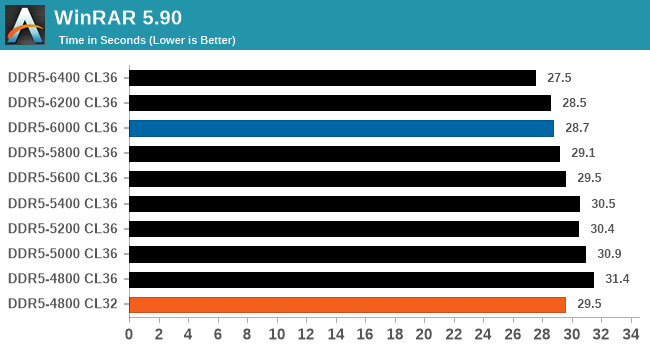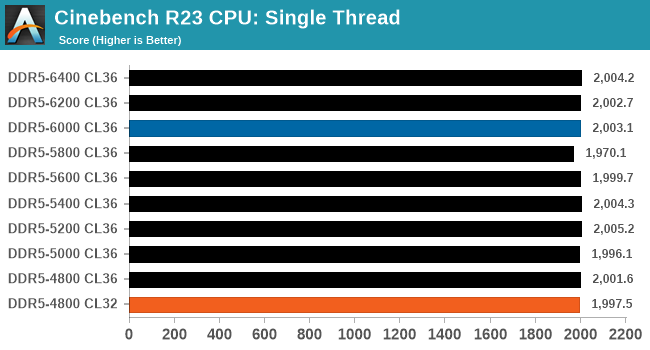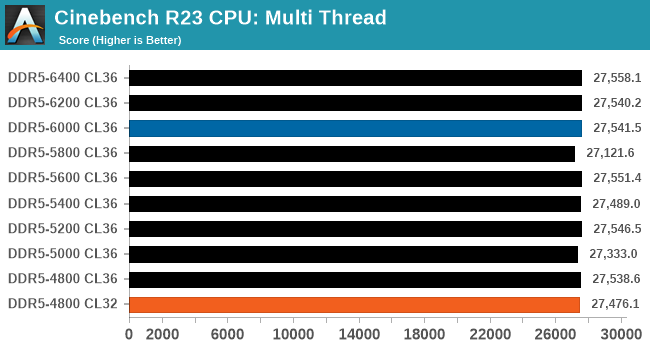Intel Alder Lake DDR5 Memory Scaling Analysis With G.Skill Trident Z5
by Gavin Bonshor on December 23, 2021 9:00 AM ESTCPU Performance, Short Form
To show the performance and scaling of DDR5 memory, we've opted for a more selective and short-form selection of benchmarks from our test suite.
Compression – WinRAR 5.90: link
Our WinRAR test from 2013 is updated to the latest version of WinRAR at the start of 2014. We compress a set of 2867 files across 320 folders totaling 1.52 GB in size – 95% of these files are small typical website files, and the rest (90% of the size) are small 30-second 720p videos.

Blue is XMP; Orange is JEDEC at Low CL
In our WinRAR 5.90 benchmark, this is where we saw the most effective and conclusive levels of performance, From DDR5-4800 CL36 to DDR5-6400 CL36, we saw an impressive 14.1 % increase in throughput. Even at the DDR5-6000 CL36 XMP, there was a 9.4% jump in performance in terms of scale from the baseline.
The DDR5-4800 CL32 also provided a good uplift in performance here. It should also be noted that WinRAR 5.90 performance can be very memory dependant, and it shows in our results.
Rendering - Blender 2.79b: 3D Creation Suite
A high-profile rendering tool, Blender is open-source allowing for massive amounts of configurability, and is used by a number of high-profile animation studios worldwide. The organization recently released a Blender benchmark package, a couple of weeks after we had narrowed our Blender test for our new suite, however their test can take over an hour. For our results, we run one of the sub-tests in that suite through the command line - a standard ‘bmw27’ scene in CPU only mode, and measure the time to complete the render.

Blue is XMP; Orange is JEDEC at Low CL
In terms of scaling performance in our Blender benchmark, we saw very little variation in performance from top to bottom. Although the Trident Z5 at DDR5-6400 CL36 did perform best, it was a modest 0.6% jump in performance from our lowest result to the best.
Rendering - Cinebench R23: link
Maxon's real-world and cross-platform Cinebench test suite has been a staple in benchmarking and rendering performance for many years. Its latest installment is the R23 version, which is based on its latest 23 code which uses updated compilers. It acts as a real-world system benchmark that incorporates common tasks and rendering workloads as opposed to less diverse benchmarks which only take measurements based on certain CPU functions. Cinebench R23 can also measure both single-threaded and multi-threaded performance.


Blue is XMP; Orange is JEDEC at Low CL
Looking at performance in Cinebench R23, the results were a little sporadic, in both the single-threaded and multi-threaded testing. All of the results in the single-threaded test were within a margin of 1.8%, with the multi-threaded results within a 1.6% level of variation from top to bottom.
3DPMv2.1 – 3D Movement Algorithm Test: link
3DPM is a self-penned benchmark, taking basic 3D movement algorithms used in Brownian Motion simulations and testing them for speed. High floating point performance, MHz, and IPC win in the single thread version, whereas the multithread version has to handle the threads and loves more cores. For a brief explanation of the platform agnostic coding behind this benchmark, see my forum post here.

Blue is XMP; Orange is JEDEC at Low CL
Similar to what we saw in both Cinebench R23 and in our Blender benchmarks, performance in our 3DPM v2.1 testing shows little to no improvement with faster memory across the range of results. The level of variation between the best result and the worst result was around 0.3%.










82 Comments
View All Comments
Targon - Thursday, December 23, 2021 - link
Looking at these numbers, and how DDR5-5800 and DDR5000 both seem to have a performance penalty, but the other numbers aren't all that different implies something in the Alder Lake design or BIOS or SOMETHING isn't making very good use of the memory.Some may just chalk it up to the RAM, but I suspect it has more to do with Alder Lake itself supporting both DDR4 and DDR5 memory. At that point, I suspect the memory controller on the CPU and how it links to the CPU cores is at fault. If the memory controller were actually making better use of the changes in DDR5 compared to 4(dual 32 bit per clock eliminating certain wait states as one example), then we SHOULD see a definite improvement with better memory and not this trivial difference.
It will be interesting to see if AMD Zen4 Ryzen shows better scaling between memory speeds, because if there is, that will show very clearly how poorly Intel implemented DDR5 memory support. Just getting it working isn't the same as taking advantage of the benefits.
mikk - Thursday, December 23, 2021 - link
They didn't test the RAM, it's a GPU test. It's called GPU limit.haukionkannel - Friday, December 24, 2021 - link
AMD use most likely more cache, so the difference will be smaller.felixbrault - Thursday, December 23, 2021 - link
Why is Anandtech still using Windows 10 for testing?!?Ryan Smith - Thursday, December 23, 2021 - link
Windows 11 has been very, er, "quirky" to put it politely. We're keeping an eye on it and running it internally, but thus far we've found it to be rather inconsistent on performance benchmarks.In the interim, even when it behaves itself and doesn't halve our results for no good reason, we just end up with results similar to Windows 10. So there's no net benefit to using it right now.
Oxford Guy - Friday, December 24, 2021 - link
Probably because Windows 11 is worse than 10.Samus - Thursday, December 23, 2021 - link
So basically the same story as ever, good timings mean almost as much as frequency, and paying ultra premiums for frequency still don't net reasonable returns on the investment.As always, just stick with reliable, quality memory at JEDEC speeds and invest the savings elsewhere.
Oxford Guy - Friday, December 24, 2021 - link
‘quality memory at JEDEC speeds’Lol, no. Certainly not with a CPU like Zen 1. There was a huge difference between JEDEC and 3200-speed DDR-4, without a huge cost increase. Zen 3 is optimal at 3600. I would think you’re aware of the fabric speed being tied to the RAM speed, hence there being a price-performance sweet spot. That spot hasn’t been JEDEC for a long time.
Your point may apply to early adopter RAM at most. Once the DDR-5 market is more mature... In this situation it looks like getting Alder with DDR-4 capable of low latencies is most optimal. Too bad there’s no data on that here.
TheinsanegamerN - Monday, January 3, 2022 - link
JEDEC DDR3 was 1066, and later updated to 1333 when everyone was running 1866 or 2133.JEDEC ddr4 is 2133 mhz, up to 2666, when 3200-3600 is the performance sweet spot.
haukionkannel - Friday, December 24, 2021 - link
Well it seems that we are not memory speed bottle necked at the current state...And timings seems to affect more than pure band wide.